Most websites fail to convert their site visitors into leads or paying customers because they neglect a very important element of site design: Their target audience’s thought process. Thinking about how your audience thinks is known as design psychology.
This can leave site visitors confused and lacking the trust and motivation required to fill out a form or pull out their credit card.
The solution is incorporating design psychology.
What is Design Psychology?
Design psychology is a repeatable methodology that you can use to understand:
- How your target audience thinks
- What’s really motivating them
- How they make decisions
- Any potential objections
- How to persuade them to act
We hosted Ross Johnson of 3.7 Designs for a live webinar covering the five-step process you can use to make sure your website and landing pages speak to your target audience and drive better results—no matter your industry.
You can watch the webinar video below, or read on to learn more.
Watch the Leverage Design Psychology Webinar Replay
Ross Johnson and his team have created a companion workbook for this event. You can grab a copy of the Web Strategy Workbook from their website here.
5 Steps to Get Into Your Buyer’s Brain
There are two ways to approach your digital business:
- Your business objectives (the reason your website exists)
- The user’s needs (the reason someone visits your site)
Your business strategy should address both of these – but as a business owner, it’s easy to over-prioritize what you want and under-prioritize what the user wants.
In reality, you should always prioritize your users.
1. Saturation Dive
Logic and emotion drive all of our actions. While humans are logical beings, we tend to make many decisions on emotion alone.
Then, we use logic to justify our choices.
Understanding your audience’s deep underlying motivations (and the logical justifications they make) can help you maximize the success of your website. Otherwise, you are just guessing – which doesn’t produce the best results.
First, you need to do some research to better understand your audience. Collect as many data points as you can when it comes to things like your:
- Target demographic
- Existing customers
- Customers that don’t actually buy (Why?)
- Company leadership
- Sales conversion rate
- Customer support experience
- Website analytics
- Competitors
- Social media engagement
Additionally, there are a few key questions about your target audience that you should answer:
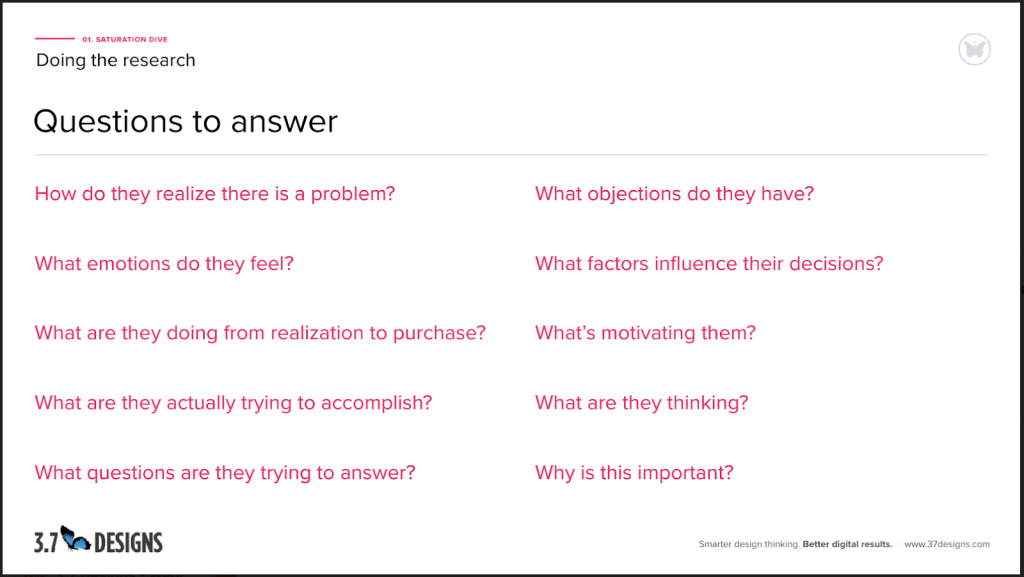
The goal of answering these questions is to create a complete understanding of your customer’s thought process on both the logical and emotional level.
2. Buyer Modeling
You may already be familiar with the buyer persona, a fictional representation of who your buyer might be. Buyer personas are helpful in understanding who you should be marketing to, but they are often focused exclusively on demographics.
What’s more effective than demographics? Psychographics.
Psychographics is the qualitative methodology of studying consumers based on psychological characteristics and traits such as values, desires, goals, interests, and lifestyle choices.
Hotjar
In other words:
- What pain points do your customers have?
- What are they thinking and feeling?
- What’s motivating them?
In addition to the buyer’s emotions and motivations, it’s important to know the questions and objections they may have to your business.
But there’s something underneath all of this, influencing everything: The buyer’s story.
The 5 Whys Technique
To understand the deeper motivations of your buyer, you can use something called the 5 Whys Technique. Toyota founder Sakichi Toyoda developed this technique in the 1930s – and it’s still used by Toyota to this day.
Asking “Why?” five times allows you to get down to the deep emotional motivator underneath the buyer’s mindset.
For example, consider a statement like, “My current car is old and is unreliable.” Asking “Why?” 5 times might lead you to discover a deeper reason that the buyer wants to buy a new car: They want a better parent and keep their children safe.
The Buyer’s Journey
The timeline that begins with the realization of a need and ends with a decision to take action is called the buyer’s journey.
There are seven key steps in this process:
- Motivation
- Awareness
- Interest
- Consideration
- Intent
- Evaluation
- Purchase
This timeline can last minutes, hours, or even months. Here’s our map of the buyer’s journey to help you visualize the process:
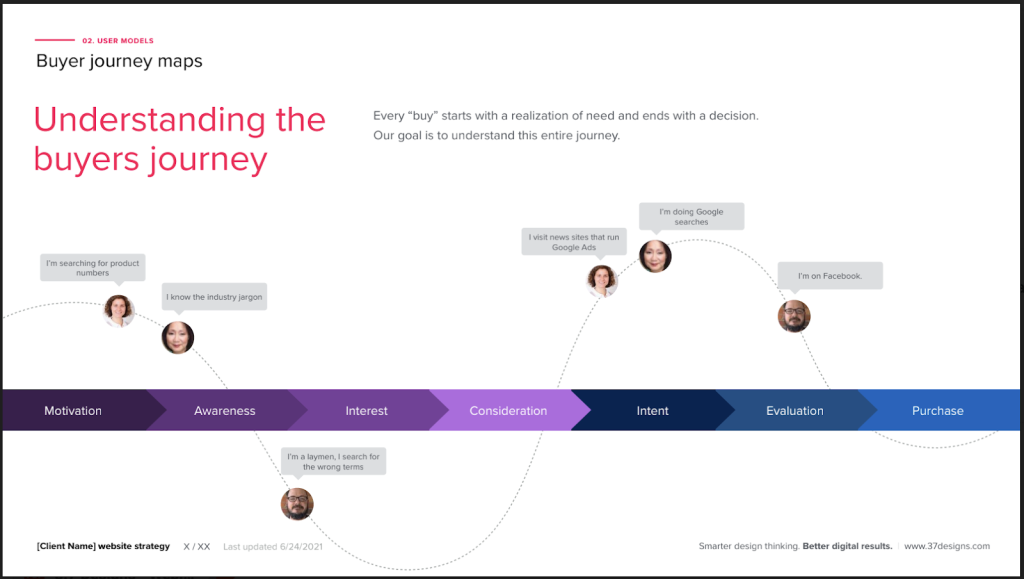
In addition to the Buyer’s Journey Map, our Empathy Map highlights the buyer’s emotional motivators, anxieties, feelings, and logical thoughts. These elements should always come into play when designing your website.
Once you understand your buyer’s emotional motivation, you can move on to the Logic Map.
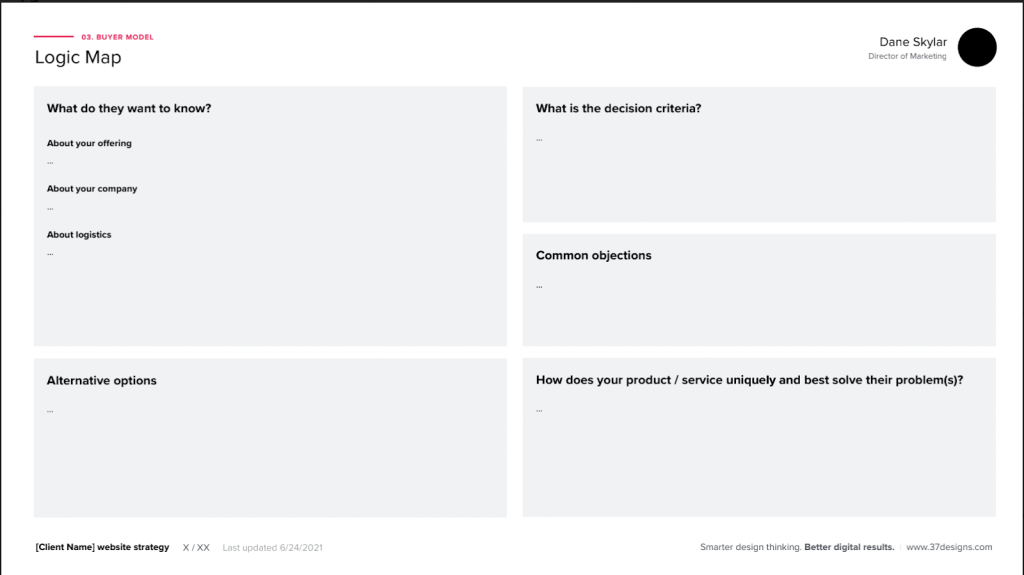
This will help you determine how to appeal to your buyer’s logic.
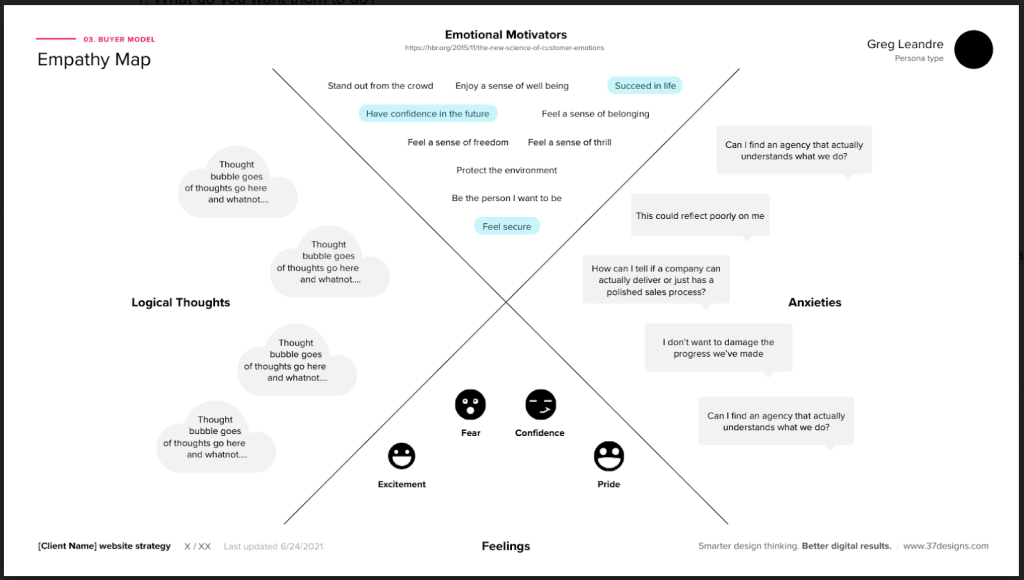
3. Messaging & Tone
Now that you have several models to help you to better understand your buyer, you can determine the tone of what you want to say (and the tone of your website).
The most effective way to do this is by using a story.
People Love Stories
Your story should follow this basic structure:
- Your buyer is encountering a problem
- The buyer meets a guide or partner that gives them a solution
- The plan calls the buyer to action
- This action results in success (or helps them avoid failure)
As the business owner, you want to structure your messaging around the idea that you are the partner, and you’re going to give the buyer a solution and the guidance they need to be successful.
Plus, you’re going to help them overcome any obstacles along the way.
First Impressions Are Important
If a someone only remembers three things about your business after visiting it, those three things should be:
- A sense of accountability, transparency, and strong, long-term relationships
- A very experienced team
- Proven results with an emphasis on efficiency
Remember: Humans have a limited memory and attention span, so people will not remember everything they see. This is why it’s important to prioritize the main points that you want to communicate to your site visitors.
Addressing the Buyer’s Concerns
In order to overcome any objections that buyers may have to your product or business, it’s important to catalog, categorize, and prioritize any common questions or concerns that you’ve discovered through your research.
These issues should be displayed together in a place that’s easy for the site viewer to access. Many businesses offer this information in the form of a frequently asked questions (FAQs) section.
Now, think about what makes you different from your competitors.
If you want to make buyers understand why you’re unique, list three primary differences between you and your competitor(s). This can give you a competitive advantage.
The Importance of Tone
Tone is mostly the voice of the website, but it also applies to the look and feel of the site. You do want to consider what your users want rather than what the business wants. This is a great branding exercise. Identify on a scale where your tone should be between two radically different characteristics. For example, should your website look and feel more conserative or more progressive?
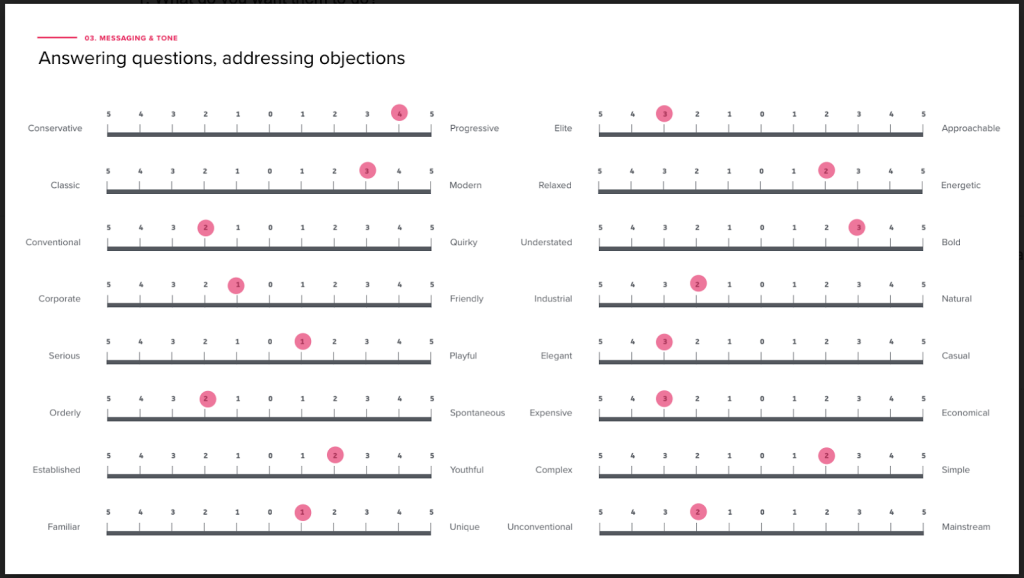
4. Page Strategy
Now that you understand your audience more, you can start thinking about a strategy for your key pages; Your buyer’s model will help you decide what each page’s top tasks are.
Your pages should speak to these three parts of the buyer’s journey in particular:
- Awareness
- Consideration
- Decision
Next, decide which pages or sections are most appropriate for this. These will be where you dedicate the most effort when it comes to your marketing strategy.
You should also consider where the conversion points are for each of these pages and sections. Ideally, you want one conversion point for each stage of the sales funnel.
This is also a good time to start thinking about persuasive design patterns. There are over 60 commonly-used patterns that are known to elicit a fight or flight response in humans, including:
- Storytelling – Persuading by inviting the reader to share your first-hand experience
- Social Proof – Persuading by showing that others approve of your product or business
- Authority – Persuading by showcasing your knowledge and expertise within your industry
Next, we want to create the user flow(s) – or the pathway we want our users to follow when looking at the content of our site.
Remember that not everyone is going to follow your content the same way. So, focus on creating an easy pathway that gently nudges your site visitors or calls them to action in some way.
Now it’s time to review your sitemap and the navigation of your website.
You’ll want to look at exactly how people are going to find the information and what information is grouped together. Then, you can figure out the pages themselves.
For the pages, remember to consider:
- The goals of the page
- The context of the page
- Your desired next step for the visitor
- The user’s desired information
5. Calls to Action (CTAs)
Finally, determining your calls to action (CTAs) is crucial to getting your site visitors to actually buy your product or service.
On a basic level, a CTA prompts your user to do something.
When you ask the user to do something like buy a product, read an article, or subscribe to a newsletter, they are simply more likely to actually do it. You should have a CTA for every stage of the sales funnel on your site.
Your CTAs should always focus on the emotional benefits of the action that you want the user to take – and there should be a logical reason to step into action.
CTAs can also be effective for resolving any objections or concerns the user might have.
Final Thoughts: Design Psychology
Once you put all of these five elements together, you will be able to approach your website with a design psychology mindset which will increase sales conversions.
Most importantly, you want to:
- Prioritize what your user needs are, and
- Play to their emotions, while backing it up with logic.
Whether you are starting from scratch or rebuilding an existing website, you should always start with the Saturation Dive if you want to better understand the psyche of your audience.
Once you understand them, you can jump into creating your buyer models. This process will help you convert your insights into an actionable buyer model.
Also remember:
- You can adjust the message and tone of your content and website by pulling out key messages, differentiators, positioning, and voice.
- It helps to structure your pages to tell a story that resonates with your audience, addresses objectives and motivates them to act.
- Lastly, use Calls to Action (CTAs) to craft compelling messages that inspire action and address any final objections or concerns that your prospective customers may have.
About the Presenter

Ross Johnson is a partner at 3.7 Designs and the founder of Project Panorama. He has been designing websites professionally for over fifteen years.
Ross brings a unique perspective to design, shaped by a lifelong love of the fine arts and his education in technology, business, and social science. This diverse background adds valuable insight to all aspects of his design work, as it enhances his practical understanding of business implications and the psychology of how people interact with computers.
Ross frequently speaks on design and marketing related topics at conferences and other venues. He has had a long history within the web design community, having co-founded Refresh Detroit, WP Ann Arbor, and LA2M.


